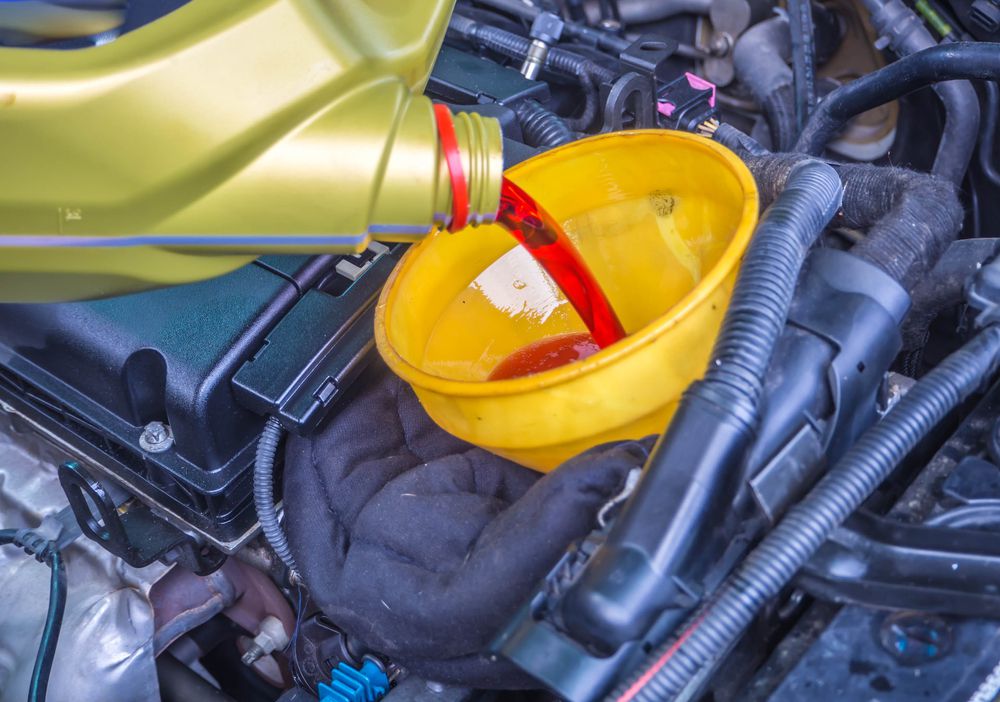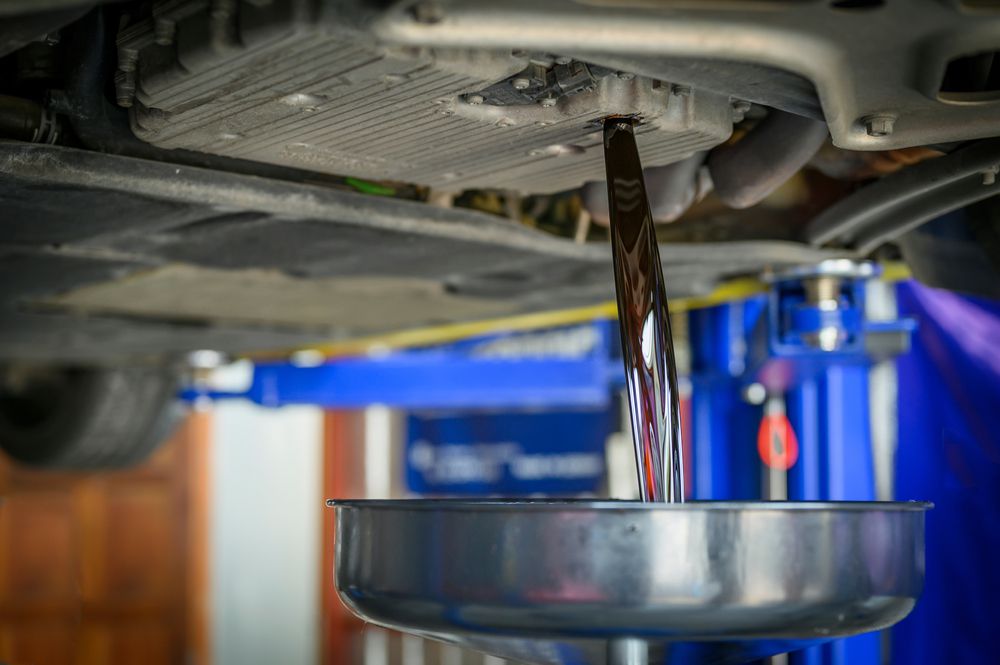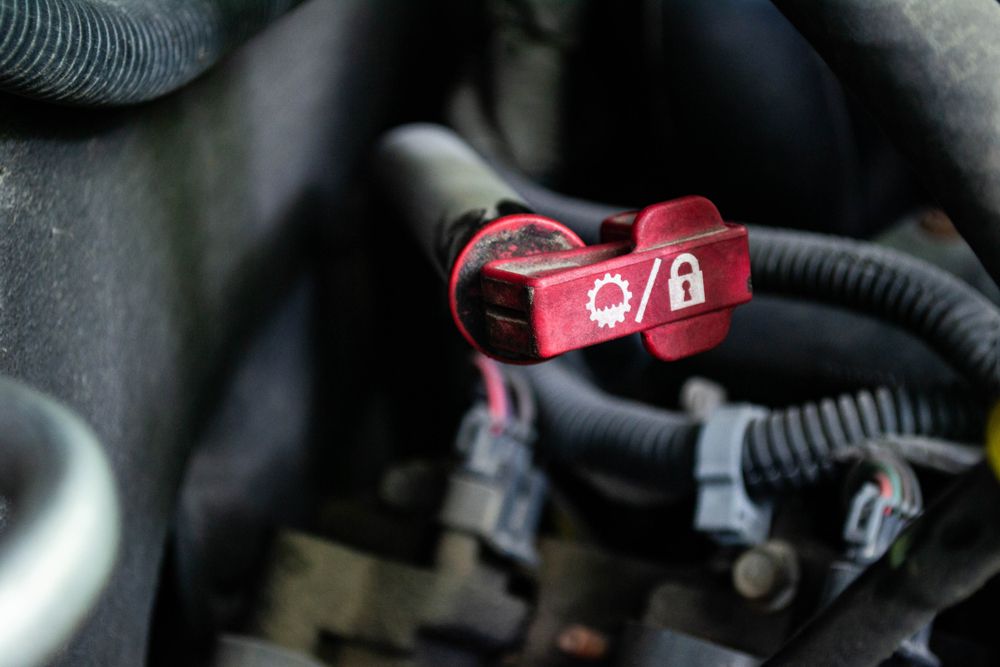Your car's transmission requires regular maintenance since it's so
important to the overall reliability of your car. You may be wondering
about how much transmission fluid it requires.
Most modern automatic transmissions use around 12 to 16 quarts of
transmission fluid to fill to normal capacity. When performing a fluid
change, replacing all of the transmission fluid at once is unnecessary.
Usually, between 2 and 6 quarts should be enough to replace what is
drained out.
How much transmission fluid you need depends on your specific vehicle. Read
on to learn more about transmission fluids and some signs you need to watch
out for.
 Mechanic filling a transmission with transmission fluid.
Mechanic filling a transmission with transmission fluid.
How much transmission fluid do I add if empty?
An automatic transmission that is completely empty requires between 12 to
16 quarts to fill up to a safe level.
Normally, your car's service manual will list the capacity of the
transmission for your specific vehicle.
A car's transmission will already come filled with the correct amount of
fluid when it is installed in the car.
Unless you have a serious mechanical issue that causes your transmission to
lose all its transmission fluid, it's unlikely that you will ever need to
replace it at once.
When checking your fluid level, be sure that you pay attention to which
dipstick you are checking.
It's important not to confuse your engine oil dipstick and transmission
dipstick. Each of these should be clearly marked.
What happens if you put too much transmission fluid in your car?
Adding too much transmission fluid to your car can cause several problems.
This can cause excess pressure to build up inside your transmission, which
can lead to damage to the gears and other components.
Excess pressure buildup can also cause the transmission seals to bulge and
leak transmission fluid.
This pressure can ruin the seals and have to be replaced.
Can I just add transmission fluid instead of changing it?
If you notice that your transmission dipstick reads that your fluid is low,
it's OK to add enough fluid to get it back to the correct level without
having to change it.
With that in mind, the fact that your transmission fluid level is low is
probably a good indication that it requires maintenance anyway.
You should take this as an opportunity to schedule a transmission service
with a professional mechanic.
 Mechanic draining old transmission fluid.
Mechanic draining old transmission fluid.
Is it OK to mix old and new transmission fluid?
It's not ideal to mix new transmission fluid with old fluid, but most
transmission services will only replace part of the fluid instead of all of
it at one time.
New transmission fluids have a certain viscosity (thickness) level that is
required to help lubricate the components and ease the shifting between
gears.
As the fluid ages and endures regular use, it starts to break down and lose
the necessary viscosity for proper performance.
Mixing in the new fluid will only help a little to increase this viscosity
level. The more ideal thing to do is to have your system flushed and
replace most of the old fluid.
Do you leave the car running when adding transmission fluid?
Adding transmission fluid with the vehicle running is the best way to
ensure that you don't add too much fluid.
If you have a warm engine and transmission, this allows the transmission
fluid to expand properly to fill all of the different components of the
transmission.
The transmission dipstick should have two marks, both a cold mark and a hot
mark, to indicate the correct fill level.
If you are adding more transmission fluid to your vehicle at operating
temperature, be sure that you use the hot mark on the dipstick to avoid
overfilling the fluid.
 Transmission dipstick.
Transmission dipstick.
What are the signs of low transmission fluid?
There are several signs to warn you of low transmission fluid levels.
The most obvious of these is a low level on the transmission fluid
dipstick. Be sure to check your dipstick regularly since it's the easiest
way to monitor your fluid levels.
Problems with your transmission shifting are another indicator of low
transmission fluid.
Your transmission can have trouble shifting correctly without transmission
fluids to lubricate its metal parts.
You may notice a jumping or lurching feeling when your transmission shifts
gears.
A noisy transmission is also a symptom of low transmission fluid. Grinding
or other metallic clunking noises during shifting are common with low
transmission fluid.
If you notice that your transmission is not shifting smoothly, it's time to
check your transmission fluid and add fluid if necessary.
Can transmission fluid get low without a leak?
Since your transmission fluid is in a sealed environment, it will not lose
fluid without a leak somewhere in the system.
Transmission fluid doesn't easily evaporate and doesn't get hot enough to
burn off, so a transmission leak is almost always going to be caused by a
leak.
You would naturally think that you will see a puddle of transmission fluid
under your car if you have a leak. This is only sometimes the case, though.
A small leak in the seals around your transmission case or fluid pan can
cause a small amount to leak out over time.
Since this transmission fluid usually leaks while driving, you may not even
notice a puddle under your car as it slowly leaks out on the road.
Is it OK to change transmission fluid without changing the filter?
If you are planning on changing your transmission fluid, it's always a good
idea to have the filter changed simultaneously.
Your transmission can accumulate small bits of metal from wear during
normal use. Most of these metal shavings will be caught by the transmission
filter.
If you don't change your filter when changing the transmission fluid, you
risk having the old filter get too clogged with metal. This can cause a
loss of fluid flow, leading to transmission damage.
Is 2 quarts or 4 quarts of transmission fluid enough?
If you are not completely flushing and replacing all of the automatic
transmission fluid, you will not need to refill the entire fluid capacity
of the transmission.
How much transmission fluid you need depends on how much you have lost from
leaks or transmission servicing.
2 to 4 quarts of transmission fluid may be enough if you are only replacing
your transmission filter, but more is needed for a complete system flush.
How many quarts of transmission fluid do I need to change the filter?
A normal transmission filter change involves a transmission pan drop and
only draining the fluid collected in the pan.
This is usually around 2 to 6 quarts of transmission fluid, which is all
that needs to be replaced after the new filter is installed and the pan is
put back in place.
As long as you replace this amount of fluid, then you will ensure that you
stay close to the exact amount required for your car.
How long does it take for transmission fluid to cycle through?
Transmission fluid usually takes less than a minute to circulate through
the entire system.
If you add transmission fluid to your system, it will take one or two drive
cycles to mix in with the existing fluid.
After servicing your transmission, it's a good idea to recheck your fluid
level to ensure it's at the correct level.
How often should you add transmission fluid?
Adding fluid is only necessary if your transmission fluid level is low or
you are having your transmission serviced.
When changing transmission fluid, you should only replace the amount of
transmission fluid that you are removing from the system.
It's important not to add more fluid than is required for your vehicle.
How far can you drive with low transmission?
If you know you have low transmission fluid, driving your vehicle is not a
good idea.
This can lead to wear of the metal surfaces inside of your transmission and
may shorten the lifespan of your vehicle transmission.
You should limit your driving to emergencies until your transmission is
refilled or serviced.
Conclusion
It's important to keep an eye on your car's transmission fluid level.
This is especially true if you are adding or changing transmission fluid
since this can change the fluid level in the system.
Luckily, this handy guide can help you know what to watch for when it comes
to your transmission fluid.